Lenovo Legion 5 15IMH05H 81Y600AKMH User manual

User Guide
Lenovo Legion 5 (15 05) and Lenovo Legion 5 (17 05) |
″ |
Read this first
Before using this documentation and the product it supports, ensure that you read and understand the following:
•Appendix A “Important safety information” on page 31
•Safety and Warranty Guide
•Setup Guide
First Edition (March 2020)
© Copyright Lenovo 2020.
LIMITED AND RESTRICTED RIGHTS NOTICE: If data or software is delivered pursuant to a General Services Administration “GSA” contract, use, reproduction, or disclosure is subject to restrictions set forth in Contract No. GS- 35F-05925.

Contents
About this guide . . . . . . . . . . . . .iii Chapter 1. Meet your computer . . . . . 1
Front |
. . . . |
. . . |
. . . . . |
. . |
. |
. . . . |
. |
1 |
Base |
. . . . |
. . . |
. . . . . |
. . |
. |
. . . . |
. |
2 |
Left |
. . . . |
. . . |
. . . . . |
. . |
. |
. . . . |
. |
4 |
Right . . . . . . . . . . . . . . . . . . . . 5 Rear . . . . . . . . . . . . . . . . . . . . 7 Bottom . . . . . . . . . . . . . . . . . . . 8 Features and specifications . . . . . . . . . . . 9 Statement on USB transfer rate . . . . . . . 10 Operating environment . . . . . . . . . . 10
Chapter 2. Get started with your computer . . . . . . . . . . . . . . . . 13
Get started with Windows 10 . . . . . . . . . |
13 |
Windows account . . . . . . . . . . . . |
13 |
Windows desktop . . . . . . . . . . . . |
14 |
Windows Updates . . . . . . . . . . . . |
15 |
Lenovo Vantage and Lenovo PC Manager . . . . |
15 |
Connect to networks . . . . . . . . . . . . . |
15 |
Connect to wired networks . . . . . . . . |
15 |
Connect to Wi-Fi networks. . . . . . . . . |
16 |
The Novo Button menu . . . . . . . . . . . . |
16 |
Open the Novo Button menu . . . . . . . . |
16 |
The Fn key and hotkeys. . . . . . . . . . . . |
17 |
The Fn key . . . . . . . . . . . . . . . |
17 |
Hotkeys . . . . . . . . . . . . . . . . |
17 |
Dual-function keys without printed icons . . . |
17 |
The FnLock switch . . . . . . . . . . . . |
18 |
Chapter 3. Explore your computer . . |
19 |
Manage power . . . . . . . . . . . . . . . |
19 |
Check the battery status . . . . . . . . . |
19 |
Charge the battery . . . . . . . . . . . . |
19 |
Set power button behavior. . . . . . . . . |
19 |
Change or create a power plan . . . . . . . |
19 |
Set performance mode . . . . . . . . . . |
19 |
Change settings in UEFI/BIOS setup utility . . . . |
20 |
What is UEFI/BIOS setup utility . . . . . . . |
20 |
Open the UEFI/BIOS setup utility . . . . . . |
20 |
Enable or disable Fool Proof Fn Ctrl . . . . . |
20 |
Enable or disable always-on . . . . . . . . |
20 |
Set passwords in UEFI/BIOS setup utility . . . . . |
20 |
Password types . . . . . . . . . . . . . |
20 |
Set administrator password . . . . . . . . |
21 |
Change or remove administrator password . . |
21 |
Set user password . . . . . . . . . . . . |
22 |
Enable power-on password . . . . . . . . |
22 |
Set hard disk password . . . . . . . . . . |
22 |
Change or remove hard disk password . . . . 22 |
|
Reset or restore Windows . . . . . . . . . . . |
23 |
Windows 10 recovery options . . . . . . . |
23 |
Windows System Restore . . . . . . . . . |
23 |
Reset Windows . . . . . . . . . . . . . |
24 |
Create a recovery drive . . . . . . . . . . |
24 |
Use a recovery drive to restore or reset |
|
Windows . . . . . . . . . . . . . . . |
24 |
Chapter 4. Help and support . . . . . |
27 |
Frequently asked questions . . . . . . . . . . |
27 |
Self-help resources . . . . . . . . . . . . . |
27 |
What is a CRU? . . . . . . . . . . . . . . . |
28 |
CRUs for your product model . . . . . . . . . |
28 |
Call Lenovo . . . . . . . . . . . . . . . . |
29 |
Before you contact Lenovo . . . . . . . . |
29 |
Lenovo Customer Support Center . . . . . . |
29 |
Purchase additional services. . . . . . . . . . |
30 |
Appendix A. Important safety information . . . . . . . . . . . . . . . 31
Appendix B. Accessibility and ergonomic information . . . . . . . . 43
Appendix C. Compliance
information . . . . . . . . . . . . . . . 47
Appendix D. Notices and
trademarks . . . . . . . . . . . . . . . 59
© Copyright Lenovo 2020 |
i |
ii User Guide
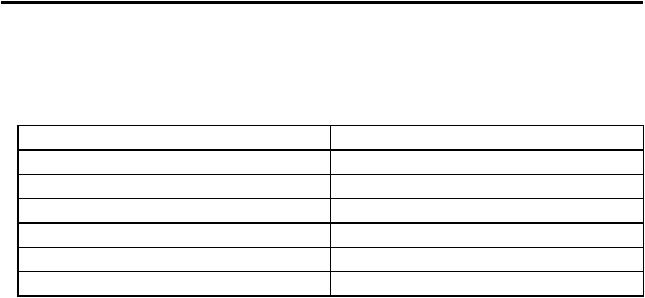
About this guide
•This guide applies to Lenovo product model(s) listed below. Illustrations in this guide may look slightly different from your product model.
Model name |
|
Machine type (MT) |
Lenovo Legion 5 15IMH05H |
81Y6 |
|
Lenovo Legion 5 15IMH05 |
82AU |
|
Lenovo Legion 5 15ARH05H |
82B1 |
|
Lenovo Legion 5 |
15ARH05 |
82B5 |
Lenovo Legion 5 |
17IMH05H |
81Y8 |
Lenovo Legion 5 |
17IMH05 |
82B3 |
•This guide may contain information about accessories, features, and software that are not available on all models.
•This guide contains instructions that are based on the Windows 10 operating system. These instructions are not applicable if you install and use other operating systems.
•Microsoft® makes periodic feature changes to the Windows® operating system through Windows Update. As a result, the operating system related instructions may become outdated. Refer to Microsoft resources for the latest information.
•The content of the guide is subject to change without notice. To obtain the latest version, go to https:// support.lenovo.com.
© Copyright Lenovo 2020 |
iii |
iv User Guide
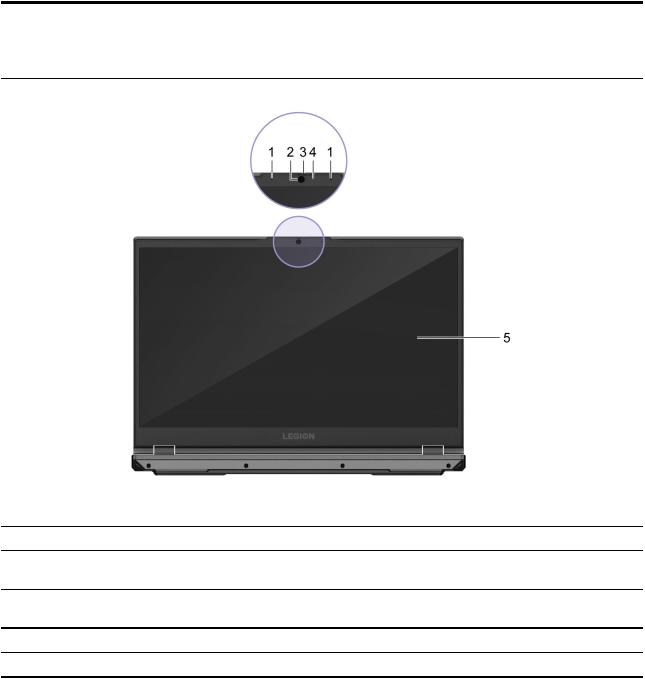
Chapter 1. Meet your computer
Front
Figure 1. Front view |
|
|
1. Microphones |
Capture or record sound and voice. |
|
2. |
Camera |
Capture still and moving images for taking photos, recording videos, |
|
|
and video chatting. |
3. |
Camera cover slider |
Move the slider to cover or uncover the camera lens. |
|
|
Note: The camera cover helps you better protect your privacy. |
4. |
Camera light |
If the light is on, the camera is in use. |
5. |
Screen |
Display text, graphics, and videos. |
© Copyright Lenovo 2020 |
1 |
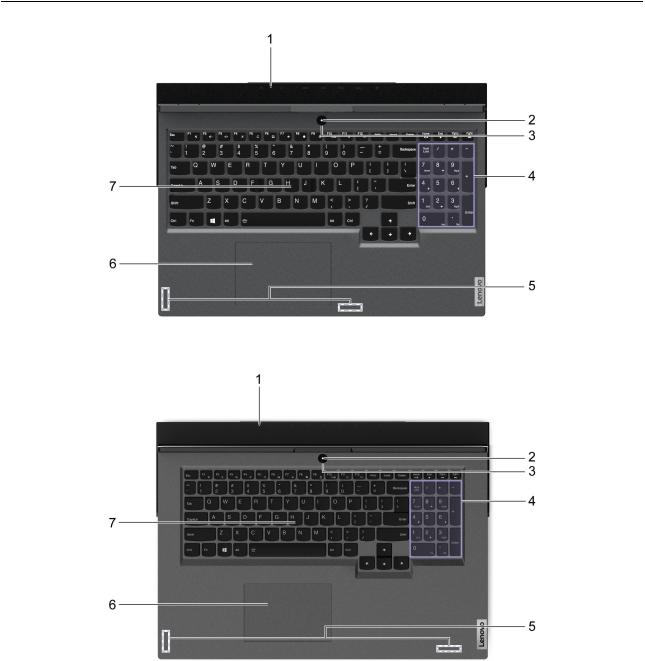
Base
Figure 2. Base view—15-inch models
Figure 3. Base view—17-inch models
2 User Guide

1. |
Charging light |
Indicate whether the computer is connected to ac power. |
|
|
• Solid white: Connected to ac power; battery charge percentage |
|
|
91%–100% |
|
|
• Solid amber: Connected to ac power; battery charge percentage |
|
|
1%–90% |
|
|
• Off: Not connected to ac power |
2. |
Power light |
Indicate the power status of the computer. The color of the power |
|
|
light also reflects the currently activated performance mode. Refer to |
|
|
“Set performance mode” on page 19 for how to switch performance |
|
|
modes. |
|
|
• Solid on: The computer is turned on. |
|
|
– White: in auto mode |
|
|
– Red: in high performance mode |
|
|
– Blue: in quiet mode |
|
|
• Blinking: The computer is in sleep mode. |
|
|
• Off: The computer is turned off or in hibernation mode. |
3. |
Power button |
Press the button to turn on the computer or put the computer into |
|
|
sleep mode. |
4. Numeric keypad |
To enable or disable the numeric keypad, press the Num Lock key. |
|
5. |
Wireless antennas |
Send and receive radio waves for the built-in wireless LAN (local area |
|
|
network) and Bluetooth module. |
|
|
Note: The antennas are not visible from the outside of the computer. |
6. |
Touchpad |
Perform finger touch and all the functions of a traditional mouse. |
|
|
Note: The touchpad also supports multi-touch function. |
7. |
Keyboard |
Enter characters and interact with programs. |
|
|
Note: The keyboard also includes hotkeys and function keys for |
|
|
changing settings and performing tasks quickly. |
Chapter 1. Meet your computer 3
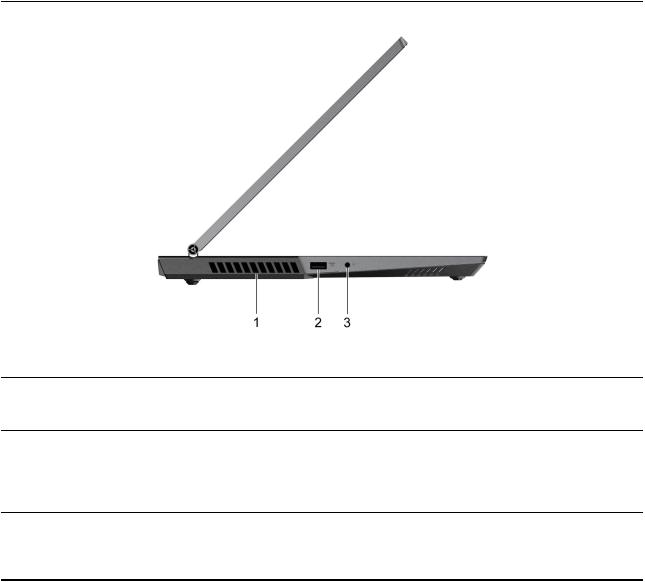
Left
Figure 4. Left-side view
1.Ventilation slots (outlet)
2.USB (3.2 Gen 1) Type-A connector (always-on)
3.Combo audio jack
Maintain the outgoing airflow to dissipate internal heat. Attention: Do not block the ventilation slots. Otherwise, the computer may overheat.
The always-on connector can charge external devices when the computer is turned off, in sleep or hibernation mode. The always-on function can be turned on or off in the UEFI/BIOS setup utility. Note: If Lenovo Vantage is pre-installed on your computer, you can also set always-on function from within that software.
Connect to headphones or headsets with a 3.5 mm (0.14 inch), 4-pole plug.
Note: This jack does not support standalone external microphones. If you use headsets, choose one with a single plug.
4 User Guide
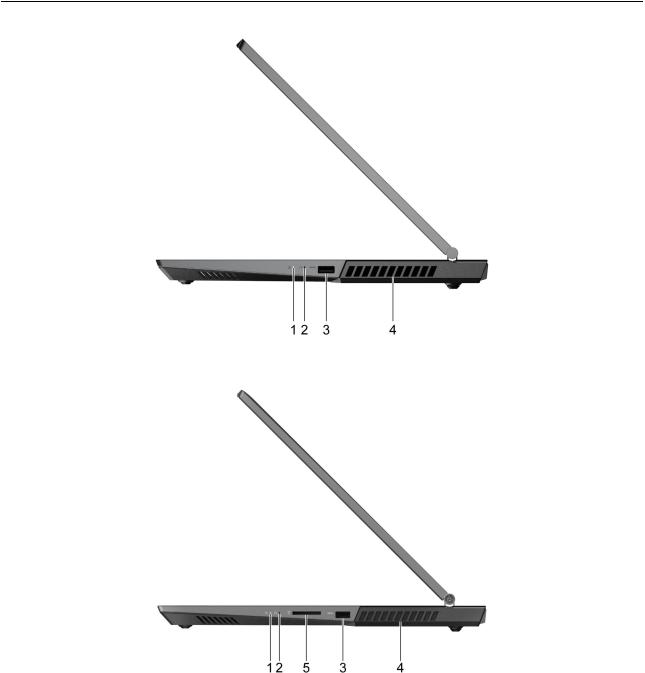
Right
Figure 5. Right-side view—15-inch models
Figure 6. Right-side view—17-inch models
Chapter 1. Meet your computer 5

1. Power light |
• Solid white: The computer is turned on; battery charge percentage |
|
|
|
21% - 100% |
|
• Blinking fast: The computer is turned on; battery charge |
|
percentage 1% - 20% |
|
• Blinking slowly: The computer is in sleep mode. |
|
• Off: The computer is turned off or in hibernation mode. |
2. Novo button hole |
Press the Novo button to open the Novo Button menu. From the |
|
menu, you can choose to open the UEFI/BIOS setup utility, the Boot |
|
menu, or the Windows startup options screen. |
3. USB (3.2 Gen 1) Type-A connector |
Connect to a USB-compatible device, such as a USB keyboard, a |
|
USB mouse, a USB storage device, or a USB printer. |
4. Ventilation slots (outlet) |
Maintain the outgoing airflow to dissipate internal heat. |
|
Attention: Do not block the ventilation slots. Otherwise, the |
|
computer may overheat. |
5. SD card slot* |
Insert an SD card or a MultiMediaCard (MMC) into the slot for data |
|
transfer or storage. |
* for 17-inch models only
6 User Guide

Rear
Figure 7. Rear view—15-inch models
Figure 8. Rear view—17-inch models
1.Ventilation slots (outlet)
2.Ethernet connector
3.USB-CTM connector
4.USB (3.2 Gen 1) Type-A connector (2)
5.HDMITM connector
6.Power connector
7.Kensington Mini Security slot
Maintain the outgoing airflow to dissipate internal heat.
Attention: Do not block the ventilation slots. Otherwise, the computer may overheat.
Connect to a local area network (LAN).
Connect to an external display, storage, or data devices.
Note: An appropriate adapter may be needed for connecting external devices.
Connect to a USB-compatible device, such as a USB keyboard, a USB mouse, a USB storage device, or a USB printer.
Connect to a compatible digital audio device or video monitor, such as an HDTV.
Connect to power with the included power cord and ac power adapter.
Lock your computer to a desk, table, or other fixtures through a compatible security cable lock.
Note: The slot supports cable locks that conform to the Kensington MiniSaver® lock standards (using CleatTM locking technology). You are responsible for evaluating, selecting, and implementing the locking device and security feature. Lenovo makes no comments, judgments, or warranties about the function, quality, or performance of the locking device and security feature. Cable locks for your product are available from Lenovo at https://smartfind.lenovo.com/.
Chapter 1. Meet your computer 7
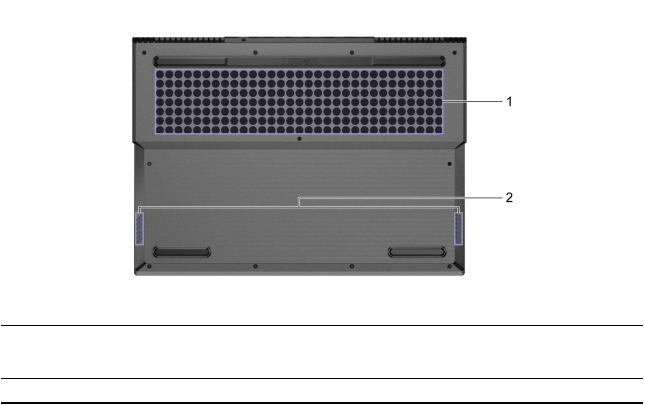
Bottom
Figure 9. Bottom view
1. Ventilation slots (inlet) Maintain the incoming airflow to dissipate internal heat. Attention: Do not block the ventilation slots. Otherwise, the computer may overheat.
2. Speakers |
Produce sound. |
8 User Guide

Features and specifications
Dimensions
ac power adapter
Battery pack
Microprocessor
Memory
Storage device
Screen
Keyboard
•15-inch models
–Width: 363.06 mm (14.29 inches)
–Depth: 260 mm (10.24 inches)
–Thickness
–Thickest: 26.1 mm (1.03 inches)
–Thinnest: 23.57 mm (0.93 inches)
•17-inch models
–Width: 402.4 mm (15.84 inches)
–Depth: 290 mm (11.42 inches)
–Thickness
–Thickest: 26.2 mm (1.03 inches)
–Thinnest: 24.3 mm (0.96 inches)
•Input: 100 V ac–240 V ac, 50 Hz–60 Hz
•Output: 20 V dc, 11.5 A / 20 V dc, 8.5 A / 20 V dc, 6.75 A
•Power: 230 W / 170 W / 135 W
•Capacity: 80 Wh or 60 Wh
•Number of cells: 4
To view the microprocessor information of your computer, right-click the Start button and then select System .
•Type: DDR4
•Number of slots: 2
•Type
–Solid-state drive (SSD)
–Hard disk drive (HDD)*
•Form factor
–SSD: M.2 (2242 or 2280)
–HDD: 2.5-inch (7 mm)*
•15-inch models
–Size: 396.24 mm (15.6 inches)
–Display resolution: 1920 × 1080 pixels
•17-inch models
–Size: 439.42 mm (17.3 inches)
–Display resolution: 1920 × 1080 pixels
•Function keys
•Hotkeys
•Numeric keypad
•Keyboard backlight
Chapter 1. Meet your computer 9

Connectors and slots
Security features
•Power connector
•Combo audio jack
•Ethernet connector
•USB (3.2 Gen 1) Type-A connector × 4 (one with always-on function)
•USB-C connector
–Support data transfer rates up to 5 Gbps for USB 3.2 Gen 1
–Support DisplayPort 1.2
•HDMI connector
•SD card slot **
•Kensington Mini Security slot
•UEFI/BIOS passwords
–Administrator password
–User password
–Master hard disk password
–User hard disk password
Wireless features
• Bluetooth
• Wireless LAN
*for selected models
**for 17-inch models only
Note: The battery capacity is the typical or average capacity as measured in a specific test environment. Capacities measured in other environments may differ but are no lower than the rated capacity (see product label).
Statement on USB transfer rate
Depending on many factors such as the processing capability of the host and peripheral devices, file attributes, and other factors related to system configuration and operating environments, the actual transfer rate using the various USB connectors on this device will vary and will be slower than the data rate listed below for each corresponding device.
USB device |
Data rate (Gbit/s) |
3.2 Gen 1 |
5 |
3.2 Gen 2 |
10 |
3.2 Gen 2 × 2 |
20 |
Operating environment
Maximum altitude (without pressurization)
3048 m (10 000 ft)
Temperature
• At altitudes up to 2438 m (8000 ft)
10 User Guide
–Operating: 5°C to 35°C (41°F to 95°F)
–Storage: 5°C to 43°C (41°F to 109°F)
•At altitudes above 2438 m (8000 ft)
–Maximum temperature when operating under the unpressurized condition: 31.3°C (88°F)
Note: When you charge the battery, its temperature must be no lower than 10°C (50°F).
Relative humidity
•Operating: 8% to 95% at wet-bulb temperature 23°C (73°F)
•Storage: 5% to 95% at wet-bulb temperature 27°C (81°F)
Chapter 1. Meet your computer 11
12 User Guide

Chapter 2. Get started with your computer
Get started with Windows 10
Learn the basics of Windows 10 and start working with it right away. For more information about Windows 10, see the Windows help information.
Windows account
You must create at least one account to use the Windows operating system. It can be either a local account or a Microsoft account.
Local accounts
A local account is created on a particular Windows-enabled device and it can only be used on that device. It is recommended that you set a password for each local account to prevent unauthorized access to the device.
Microsoft accounts
A Microsoft account is a user account that you use to sign in to Microsoft software and services. If you use Microsoft services like OneDrive, Outlook.com, Xbox Live, Office 365, and Skype, you might already have one. If you don't have it, you can create one for free.
There are two main benefits of using a Microsoft account:
•Sign in only once. If you use a Microsoft account to sign in to Windows 10, you don’t need to sign in again to use OneDrive, Skype, Outlook.com, and other Microsoft services.
•Settings can be synced. If you use your Microsoft account to sign in to multiple Windows-enabled devices, certain Windows settings can be synced among the devices.
Switch between a local and a Microsoft account
If you are using a local account to sign in to Windows 10, you can switch to use a Microsoft account instead.
Step 1. Open the Start menu and select Settings Accounts
Step 2. Select Sign in with a Microsoft account instead
Step 3. If you already have a Microsoft account, enter the account name and password to sign in. Otherwise, select Create one to create a new Microsoft account.
Note: The device must have Internet access the first time you use a Microsoft account on that device.
If you want to switch back to use a local account, open the Start menu and select Settings Accounts Sign in with a local account instead .
Add additional user accounts
Your user account must be of the “Administrator” type to add additional user accounts to Windows. Add additional user accounts if you need to share your computer with family members or other users.
Step 1. |
Open the Start menu and select Settings Accounts Family & other users |
|
Step 2. |
Select Add someone else to this PC |
. |
© Copyright Lenovo 2020 |
13 |
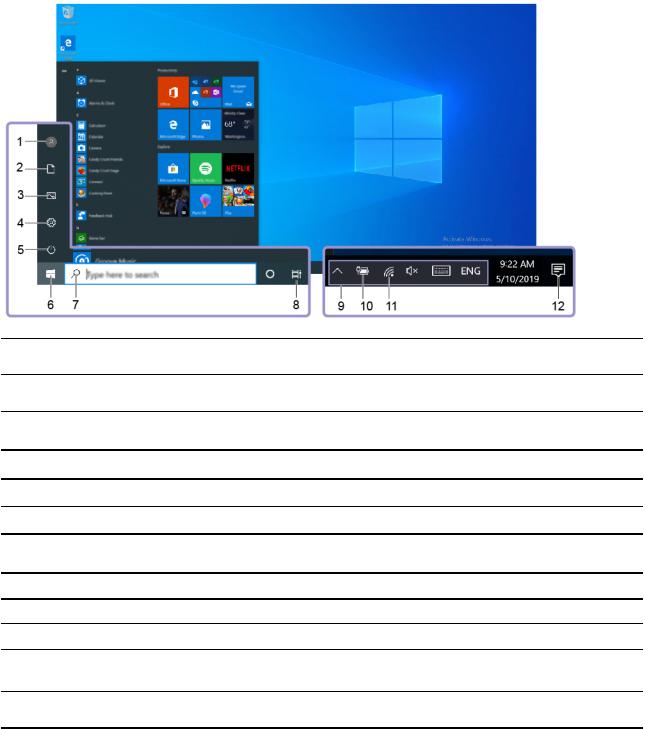
Note: To add family members, you need to sign in with a Microsoft account.
Step 3. Set the user name and password for the user account.
Windows desktop
1.Account 
2.Documents 
3.Pictures 
4.Settings 
5.Power 
6.Start button 
7.Windows Search 
8.Task View 
9.Windows notification area
10.Battery status icon

11.Network icon
12.Action center 
Open the Start menu
• Click the Start button.
Change account settings, lock the computer, or sign out of the current account.
Open the Documents folder, a default folder to save your received files.
Open the Pictures folder, a default folder to save your received pictures.
Open Settings.
Shut down, restart, or put the computer into sleep mode.
Open the Start menu.
Enter what you are looking for in the search box and get search results from your computer and the Web.
Display all opened apps and switch between them.
Display notifications and status of some features.
Display power status and change battery or power settings.
Connect to an available wireless network and display the network status. When connected to a wired network, the icon changes to  .
.
Display the latest notifications from apps and provide quick access to some features.
14 User Guide
